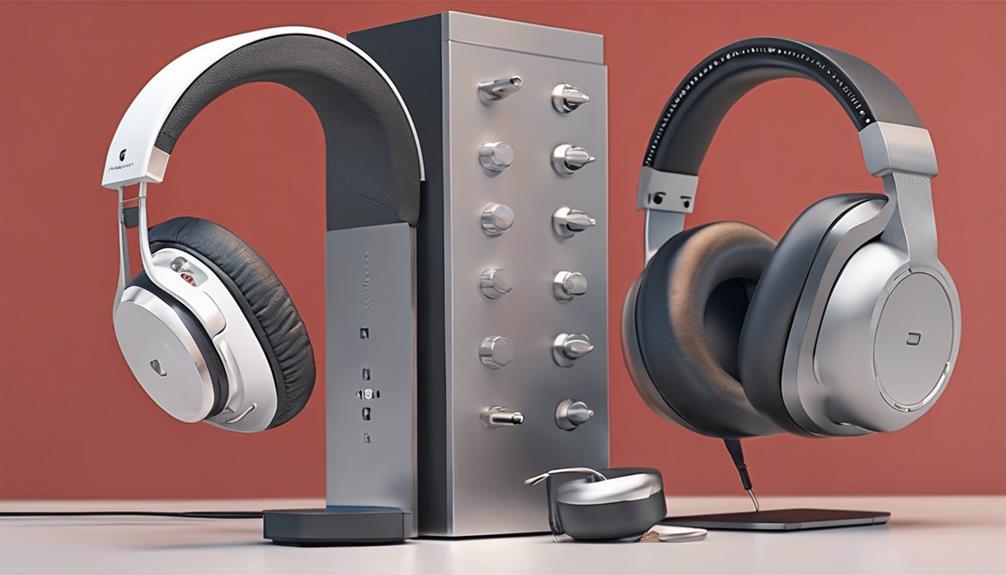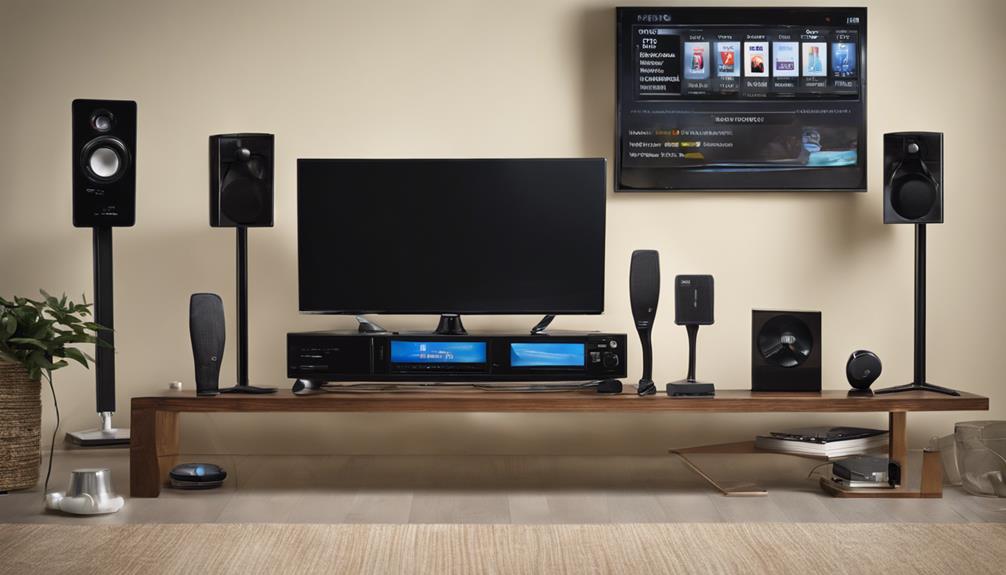The saying, “Necessity is the mother of invention,” is definitely applicable in the world of assistive listening devices for people with hearing impairments, where a variety of options are available.
From hearing loop systems to Bluetooth technology, these devices aim to enhance sound transmission and improve communication.
But which ALD is the most suitable for your specific needs? Let's explore the various types and functionalities of these devices to help you navigate the world of assistive listening technology.
Key Takeaways
- FM, infrared, personal amplified, and Bluetooth systems offer diverse options for improving sound transmission in various settings.
- Hearing loop systems provide efficient sound transmission in large venues and seamlessly integrate with hearing aid technology.
- Personal amplified devices ensure privacy, speech clarity, and versatility for one-on-one conversations in different environments.
- Bluetooth technology enhances wireless connectivity, personalized listening experiences, and compatibility with various devices for hearing assistance.
Types of Assistive Listening Devices
We'll explore various types of assistive listening devices designed to enhance communication for individuals with hearing impairments.
Assistive Listening Devices (ALDs) come in different forms to cater to diverse needs. FM Systems utilize radio waves for wireless transmission, ideal for group settings like meetings or classes, indoors and outdoors.
Infrared Systems transmit sound wirelessly through light beams, perfect for indoor environments such as theaters and churches, with options for home TV listening.
Personal Amplified Systems are portable devices suitable for one-on-one conversations or TV listening, offering convenience both indoors and outdoors.
Bluetooth Systems use Wi-Fi to transmit sound, compatible with Bluetooth-enabled hearing aids, providing flexibility for various settings.
These devices aim to improve audio induction, eliminate background noise, and offer wireless transmission, enhancing communication for those with hearing impairments.
Each type serves a specific purpose, whether for large venues or personal use, contributing to a more inclusive environment for individuals with hearing challenges.
Audio Induction or Hearing Loop

Audio Induction or Hearing Loop systems offer a direct transmission of sound via electromagnetic energy, ensuring clear reception by eliminating background noise. These systems are particularly suited for large venues like airports and banks due to their ability to enhance sound quality for individuals with or without hearing aids.
Users with telecoils in their hearing aids can benefit from improved sound clarity when connected to hearing loop systems commonly found in theaters, churches, and other public spaces.
Loop System Benefits
Utilizing electromagnetic energy, Hearing Loop systems efficiently transmit sound directly to receivers, offering individuals with hearing impairments a clear listening experience by eliminating background noise.
- Ideal for large spaces like airports, banks, and theaters.
- Telecoils in hearing aids enhance sound clarity by receiving signals from hearing loops.
- Cost-effective solution for improving sound transmission in public settings.
- Eliminates the need for additional bulky equipment, seamlessly integrating with existing hearing aid technology.
Loop Installation Process
When installing a Hearing Loop system, the first step involves positioning the copper wire loop around the designated room or area for sound transmission. This process utilizes audio induction technology to transmit audio signals directly to telecoil-equipped hearing aids. By connecting the loop to a sound system or microphone, individuals with hearing loss can benefit from improved sound quality in public venues like theaters and churches. Users simply switch their devices to the T-coil setting to access the loop's signal, effectively eliminating background noise and enhancing the clarity of the audio received. The installation of hearing loops is crucial for creating inclusive environments that cater to the needs of individuals with hearing impairments.
| Installation Process | Benefits | Locations |
|---|---|---|
| Position copper wire | Improved sound quality | Theaters |
| Connect to sound system | Background noise elimination | Churches |
| Switch to T-coil setting | Clear reception for hearing aids | Public venues |
FM Systems for Hearing Impairments
FM Systems utilize radio waves to transmit sound wirelessly, aiding individuals with hearing impairments. These systems are commonly deployed in various settings to enhance auditory accessibility, comprising a transmitter, microphone, and receiver for effective sound amplification.
The adjustable volume and customizable settings of FM Systems cater to the diverse needs of users seeking improved listening experiences.
FM System Functionality
In enhancing auditory clarity and reducing background noise, FM systems for hearing impairments use radio waves to transmit sound wirelessly. These systems are commonly applied in group settings such as classrooms, churches, and meetings.
- FM systems facilitate improved sound clarity for individuals with hearing impairments.
- These systems effectively reduce background noise, enhancing the listening experience.
- FM systems offer a portable solution for challenging listening situations in various environments.
- They're suitable for both indoor and outdoor settings, providing flexibility and accessibility.
Benefits of FM
Utilizing radio waves to transmit sound wirelessly, assistive listening devices employing FM technology offer a range of benefits for individuals with hearing impairments. FM systems provide clearer reception in group settings, reducing background noise and improving understanding, especially in environments like classrooms, churches, and meetings. Their portability allows for versatile indoor and outdoor use. Users can connect FM receivers to their hearing aids or cochlear implants, enhancing sound quality and creating personalized listening experiences. The technology behind FM systems significantly enhances speech intelligibility, making them invaluable tools for individuals with hearing impairments.
| Benefits of FM Systems | |
|---|---|
| Clearer reception in group settings | Reduced background noise |
| Improved understanding | Portability for various environments |
| Enhanced speech intelligibility | Personalized listening experiences |
FM System Types
When considering FM system types for individuals with hearing impairments, one must understand the diverse range of options available to meet varying needs and preferences. FM systems utilize wireless transmission to enhance sound clarity and reduce background noise, making them ideal for various settings such as group meetings, churches, classrooms, indoor, and outdoor environments.
These systems typically consist of a transmitter located near the sound source and a receiver worn by the listener, ensuring optimal reception and quality. The versatility of FM systems allows for seamless integration into different scenarios, providing individuals with hearing impairments the necessary support to engage effectively in communication.
- Wireless transmission enhances portability and ease of use.
- Sound clarity is significantly improved, aiding in comprehension.
- Background noise reduction promotes focused listening.
- Suited for diverse settings like group meetings, churches, classrooms, indoors, and outdoors.
Infrared Systems for Improved Hearing

Infrared systems revolutionize sound transmission by utilizing invisible light beams, making them a preferred choice for indoor environments such as churches and theaters. These systems are particularly beneficial for home TV listening, offering clear sound reception without interference. One key advantage of infrared devices is their ability to provide privacy by keeping the signal confined within the room, facilitating confidential conversations. Additionally, they excel in reducing background noise and enhancing speech clarity for individuals with hearing impairments. The versatility of infrared systems allows for their use in various settings, providing a portable solution for improved hearing on the go.
| Features | Description | Benefits |
|---|---|---|
| Invisible Light Beams | Utilizes light beams for signal transmission, ensuring privacy and security | Confidential Conversations |
| Background Noise Reduction | Effectively reduces ambient noise, enhancing the clarity of speech for the listener | Improved Speech Clarity |
| Portable Solution | Lightweight and easy to transport, making it convenient for various listening needs | Versatile Usage in Different Settings |
Personal Amplified Devices

Enhancing sound clarity and minimizing background noise, personal amplified devices like the Pocketalker provide a valuable solution for individuals with hearing impairments. These devices amplify sound for one-on-one conversations, using a hand-held amplifier with a microphone to bring sound closer to the user's ears. They effectively filter out background noise, enhancing sound clarity in noisy environments. Personal amplified devices are ideal for individuals with hearing impairments, facilitating improved communication in various settings such as family gatherings or social events.
- Personal amplified devices like the Pocketalker amplify sound for one-on-one conversations.
- These devices use a hand-held amplifier with a microphone to bring sound closer to the user's ears.
- They help filter out background noise to enhance sound clarity in noisy environments.
- Ideal for individuals with hearing impairments to improve communication in family gatherings or social settings.
Bluetooth Technology for Hearing Assistance

Bluetooth technology enhances the functionality of assistive listening devices by enabling wireless sound transmission directly to compatible hearing aids. This advancement allows for seamless connectivity with smartphones, TVs, and various devices, resulting in improved audio quality and personalized listening experiences. Through smartphone apps, users can effortlessly adjust volume levels and settings to suit their preferences, ensuring a tailored and comfortable listening experience. Additionally, Bluetooth technology enables individuals to stream music, phone calls, and other audio content directly to their hearing aids, offering convenience and versatility. These Bluetooth-enabled ALDs not only enhance accessibility but also provide ease of use for those with hearing impairments, making everyday activities more manageable and enjoyable.
| Bluetooth Technology Features | Benefits | Compatible Devices |
|---|---|---|
| Wireless Sound Transmission | Enhanced audio quality | Hearing Aids, Smartphones |
| Seamless Connectivity | Convenient usage | TVs, Tablets |
| Personalized Listening Experiences | Tailored settings | Laptops, Music Players |
Where to Purchase ALDs

When considering where to purchase Assistive Listening Devices (ALDs), individuals can explore specialty retailers offering a diverse range of options tailored to specific needs. These retailers can assist in finding the most suitable ALD based on individual budget considerations and intended settings.
Some key points to keep in mind when looking for where to purchase ALDs include:
- Specialized vendors listed on specific vendor lists can facilitate the process of locating and purchasing ALDs.
- Prices for ALDs vary depending on features, benefits, and individual budget considerations.
- Considering the intended use and settings where the ALD will be utilized can guide individuals in selecting the most appropriate device.
- Researching and comparing different retailers can help individuals find competitive prices and the best deals on ALDs.
Exploring these avenues can help individuals with hearing impairments find the right ALD to enhance their auditory experience in various settings.
Frequently Asked Questions
What Are the Assistive Listening Devices for Hearing Impaired People?
We'll detail various assistive listening devices for those with hearing impairments.
Hearing loop systems use electromagnetic energy. FM systems transmit sound wirelessly via radio waves. Infrared systems use light beams.
Personal amplified systems are portable for one-on-one conversations, while Bluetooth systems connect via Wi-Fi. Each device aids individuals in different settings and situations, catering to a range of hearing needs.
What Devices Are Available to Assist With Communication for Visually or Hearing Impaired?
When considering devices for individuals with visual or hearing impairments, it's essential to explore a range of options.
Augmentative and alternative communication (AAC) devices like speech-generating tools enhance communication. Alerting devices, such as visual clocks and vibrating alarms, aid those with hearing impairments.
Customizable AAC solutions adapt to specific needs, making communication more effective. By understanding these devices, individuals can select the most suitable tools for improved communication.
What Are the Listening Devices for Apd?
When it comes to Auditory Processing Disorder (APD), various assistive listening devices are available to improve comprehension and sound processing.
FM systems, sound field systems, and personal amplification devices, like Pocketalkers, play a crucial role in aiding individuals with APD.
These devices help reduce background noise, distribute sound evenly in a room, and enhance sound clarity for better auditory information processing.
What Type of Aid Is Used for Hearing Impaired Persons?
When addressing the type of aid utilized by hearing-impaired individuals, various assistive listening devices come into play. These aids, such as hearing loops, FM systems, and infrared systems, work to enhance sound quality and minimize background noise in diverse environments.
Telecoils, commonly integrated into hearing aids, can receive signals from hearing loops for improved sound clarity. Additionally, cochlear implants can be paired with external accessories to incorporate telecoil functionality in assistive listening devices, ultimately aiding in sound transmission and communication effectiveness.
Conclusion
In conclusion, a plethora of assistive listening devices are available for individuals with hearing impairments. From Audio Induction to Bluetooth technology, these tools provide enhanced sound transmission in various environments.
Whether seeking clarity in crowded spaces or during one-on-one conversations, ALDs offer solutions to improve communication experiences. Explore the options available and find the perfect device to amplify auditory access and alleviate auditory obstacles.











